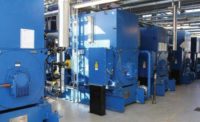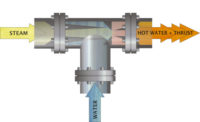Economic development is defined as activity that enhances the economy’s capacity to produce goods and services and create or retain employment opportunities. The economies of countries widely using district energy benefited substantially from the development of the district energy/heat pump (DE/HP) infrastructure. District energy customers experience substantial energy savings along with an improved environment and economic developments. The reduction in energy cost in the cities helps to attract new business and makes it easier for existing customers to remain in business and expand. Moreover, the increase in business profitability and consumer purchasing power, which results from lower energy costs, stimulates business investment and consumer spending and furthers employment growth.
Background
Energy can be a significant driver for growth and development of business for the health and welfare of residents as well as energy stability for cities and communities of all sizes. Until recently, for a majority of property owners, businesses, and local governments, energy has been little more than a utility and a bill to pay. Similarly, land-use planners and property developers have not needed to be concerned about the energy cost of tenants, residents, and building owners. But the growing threat of climate change, emphasis on greenhouse gas emission (GHG) by traditional energy arrangements, and concern about national and local energy security are increasingly focusing attention onto local energy opportunities.
In a number of states, tax incentives and other energy and environmental policies have opened up opportunities to put assets to more productive use while meeting wider social and environmental objectives. To take advantage of these benefits, many communities, municipalities, utilities, and other public sector organizations, as well as businesses and landowners, are actively considering becoming energy producers. District heating and cooling integrated with heat pumps is the local production and distribution of thermal energy. It is a highly efficient means of providing locally generated energy for municipalities. The DE/HP system consists of two major elements:
- Central or distributed heat pump plants containing equipment that produces energy for heating and cooling, and domestic hot water; and
- A network of pipes distributing the thermal energy from the DE/HP plant to the buildings.
Modern district energy systems are widespread in countries across Europe and Asia and are established in several U.S. cities. The systems deliver a range of social, sustainability, environmental, and economic benefits by providing reliable, efficient, clean, and affordable thermal energy from locally controlled and highly efficient plants. For heat sources, DE/HP systems can use ground soil, local lakes, rivers, sewage plants, solar, flue gases, and waste heat from commercial and industrial sources (Figure 1).
The DE/HP systems are also able to capture and distribute surplus heat from industrial processes and power generation that would otherwise be wasted. Heat networks aggregate the thermal demand of multiple buildings to a scale that enables the use of technologies with higher efficiencies or ones that may not be economical to deploy at the individual building level.

Role of Energy Price in Business Decisions
Geographic variation in energy prices gives businesses some degree of control over the prices they pay but only to the extent that they can select one location over another. As a result, energy prices are an important factor in business location and expansion decisions. Other considerations of varying importance, depending on the type business, include availability and reliability of energy supply, availability of raw materials and other products, access to capital, proximity to transportation systems and markets, availability of a skilled workforce, labor costs, taxes, government regulations, and environmental policies.
In a national survey of businesses, 81% of respondents considered energy costs to be either an important or very important site-selection factor. This was also substantiated by the experience of New York’s Empire State Development, which has found that energy costs are often cited by business as the first or second most important location consideration.
Surveys show the cost of energy represents about 8% of total product cost. This fact, however, may be a misleading indicator of how energy prices can affect profits. In many businesses, profit margins are extremely thin. An energy cost reduction, therefore, can have a substantial effect on a business’s profitability. Moreover, facilities compete not only with those of other companies but with facilities of the same company located in areas with substantially lower operating costs. In some cases, same-company facilities compete for additional capacity and jobs; in other cases, they complete to remain in operation. Corporations routinely favor locations that have the greatest profit potential. Less profitable facilities will, at best, not be expanded. At worst, they will be closed, with a resultant loss of jobs. In this way, energy costs have a significant and direct effect on economic development.
The Societal Economic Benefits
DE/HP systems allow two sorts of energy savings: first, fossil fuel currently burned is replaced by renewable energy source; and second, the absolute amount of energy used is reduced through increased efficiency of the heat pumps operation. In addition, the electric cost for running the electric heat pumps could be reduced by use of water storage, shifting the load away from on-peak hours. This higher efficiency leads to lower costs over the long term, especially when using local resources.
The coefficient of performance (COP) of heat pumps can vary from 3-6 depending on the source of the heat. Also, using electricity from local solar photovoltaic (PV) and wind sources will help to reduce the losses in the local distribution electric grid — average 6% based on U.S. Energy Information Administration (EIA) information. According to the New York State Energy Research and Development Authority (NYSERDA), the heat pumps are two to four times as efficient as conventional oil, propane, or electric resistance heating. They are also a safer and healthier choice for homes with no combustion of fossil fuels, fuel storage, or carbon monoxide emissions. The potential DE/HP system savings depend on the seasonal efficiency of existing individual heat sources replaced by DE/HP systems. Extensive surveys demonstrate the seasonal (annual) efficiency of individual boilers aged more than 10 years is about 55%2, while the seasonal efficiency of the heat pumps with a COP of 4 is 400%. The extensive district heating experience in the state of New York (cities of Jamestown [Figure 2], Buffalo, and Schenectady) demonstrates that fuel saving recognized from replacement of existing individual boilers with DE amounts to 35%-40%.
The ability of DE/HP networks to take heat from multiple sources and technologies makes it very flexible. Communities have a more secure energy supply as they are not solely dependent on a single source of energy. DE/HP networks allow town and city managers to secure the optimum supply option. Lastly, DE/HP’s are “future-proof” communities, since new and emerging technologies can be easily and rapidly retrofitted, without the need to install equipment in each building.
Environmental Advantages and Development Potential
High resource efficiency in using renewable sources leads to substantial reduction of carbon footprint. This will make a valuable local contribution to the global threat of climate change.
The reduction of energy costs will make the local businesses more competitive with other states and regions of the nation. As a result, the city is better able to attract new businesses and retain and expand existing business. Moreover, lower energy costs increase business profitability and consumer spending and contribute to continued job growth.
Generally, incremental jobs, wages, and output of goods and services created as a result of an energy cost reduction would be sustained over time because the incremental business profits and consumer purchasing power would be available in each subsequent year, resulting in a continued higher level of business investment and consumer spending.
Savings that result from DE/HP systems can be used to foster additional business and consumer investment as well as to increase consumer spending for non-energy related products and services, some of which create additional new jobs in the city. In addition to the jobs created by spending of energy savings, jobs are created by the purchase and installation of new equipment, to the extent that the equipment or its components are installed by city labor.

Local and Regional Retention of Funds and Jobs
The DE/HP system provides economic benefits at the state, local, and federal level far in excess of the simple cost savings. Essentially, this occurs because money spent for labor stays in the local community. Extensive experience with DE systems demonstrates that urban DE allows retaining locally 73% of the energy savings costs, while, for a traditional system with distributed boilers and furnaces, this number is only 31%.
As mentioned, the construction and operation of the system provides jobs for workers from the local and surrounding communities. The money from their paychecks, in turn, stays in the local community buying local goods and services. This “multiplier effect” thus has an impact at the local and regional levels. At the local level, the U.S. Department of Commerce estimates a dollar spent locally will be recycled three times in urban areas.
Keeping the money in the local economy also has a strong positive effect on the financing of local government through sales and income taxes. A construction and maintenance worker in the DE/HP system will pay income tax and then spend the money on goods and services. A substantial portion of the worker’s income goes to items that are taxed, and these revenues flow to the local government. And even for non-taxed items, such as groceries, the workers’ expenditures go in part to the store clerk’s salary, which is taxed, and then to the fraction of his or her purchases, which are also taxed. Of course, the fraction of each original dollar that remains to be taxed is smaller at each step in the iteration, but the result is still a much more substantial contribution to the local government’s finances than might be apparent at first glance. The DE/HP project will be combined with and serve as a stimulus to other economic development projects in city downtown, including commercial development and affordable housing.
Most reconstruction and new developments in a city can be combined with the installation of a DE/HP system. The municipal government goals can be combined with electric utilities’ desire to increase of electric sales for heat pump operation.
The DE/HP piping and electric cables installation can be combined with other municipal projects, like potable water and sewer replacement or repair. In some cities, the DE/HP-related work could be combined with separation of sanitary and storm sewer system work, providing substantial savings in the costs of opening streets and financing integrated projects, which is more efficient than doing it for a collection of nominally unrelated activities. And, the reliable, cost-effective energy supply and environmental benefits inherent in the DE/HP system can serve as an inducement to join in the urban redevelopment effort.
For example, the extensive experience with DE systems in the NYS cities demonstrated the following advantages:
- The cities’ economies benefited substantially from the development of the DE systems;
- The cost of energy of the customers was reduced;
- The cities' environments were improved; and
- The cities’ revenue was increased by the payment of the lieu of taxes by the DE system.
For example, during the system operation, the district heating customers of Jamestown experienced a cumulative savings of $16 million from participating in this system instead of operating their individual equipment. The reduction in energy cost in Jamestown helped to attract new business and made it easier for existing customers to remain in business and expand. Moreover, the increase in business profitability and consumer purchasing power, which results from lower energy costs, stimulated business investment and consumer spending and furthered employment growth.
Local and Regional Employment Increases
The local and regional employment is stimulated both on a short-term basis during construction and continually over the life of the project. The job skills required for DE/HP system construction include wells drilling, piping installation, construction and assembly, and straightforward labor. These skills are available and even in surplus in the local municipal labor market.
While imported energy supplies also contribute to some economic activity, investment in cost-effective DE/HP systems reduce economic leakage, as more dollars are retained in the economy, thereby increasing discretionary income within the city. Savings that result from DE/HP systems can be used to foster additional business and consumer investment as well as to increase consumer spending for non-energy-related products and services, some of which create additional new jobs in the city. In addition to the jobs created by spending of energy savings, jobs are created by the purchase and installation of new equipment to the extent that the equipment or its components are manufactured in the city or state and installed by city labor.
The permanent jobs created can be estimated using the following methodology: Every clean energy construction job investment of $92,000 creates one permanent direct job3. The above referenced document also indicates that $1 million investment creates five indirect jobs and 0.4 (direct and indirect jobs) induced jobs.
While the direction of the net job creation from investing in energy efficiency is clear, the precise number of jobs created is highly site- and industry-specific and very sensitive to assumed parameters regarding business and consumer spending patterns, payback periods, and useful life spans of the technologies installed.
Energy Programs Promoting Economic Development
The population of the state of New York is steadily shrinking as a share of the national total, and the biggest reason for the trend has been a heavy outflow of New Yorkers to other states. In line with a long-term pattern, the Empire State has lost a net 1.4 million residents to the rest of the country since 2010, including nearly 181,000 in 2018-2019 alone, according to the latest annual Census Bureau estimates. The statistics shows New York boasts the largest amount of outmigration of citizens of any state.
New York’s government has taken a number of steps to make the state more attractive to businesses by reducing state taxes, providing incentives to lower local taxes, and modifying or removing certain regulations that hinder business productivity and economic growth. New York’s success in working with businesses that could relocate or expand frequently depends on the availability of low-cost energy offered by energy providers and state-sponsored programs.
For many years, the cities like Jamestown, NY fostered economic growth by providing low-cost electricity and thermal energy to commercial, industrial, and residential customers and establishing economic development zones pursuant to state law. Many cities have designed economic development programs to suit the needs of their particular customers by offering varying levels of discounts from the standard energy rates. These programs are designed to encourage business retention and expansion and to encourage new business to expand while preventing rate increases for remaining customers that might otherwise be necessary if the participating customers were to leave the city.
NYSERDA’s research and development programs encouraged economic development by improving energy efficiency, reducing greenhouse gases, promoting New York State-manufactured energy and environmental products, and maximizing the contribution of the state’s renewable and indigenous energy resources. These objectives were achieved by creating a partnership with cities and towns to advance development of DE systems as well as facilitate and transfer new technologies into the marketplace.
How to Start the Development
The development of the DE/HP system needs a project champion. The easiest implementation option — municipal control of the DE/HP system — should be used as an economic development tool by the city to attract customers. The successful development of the DE/HP system in a city or town is the result of a well-coordinated effort, starting with the system’s conception to its operation and growth. The system should be implemented in stages, starting with a pilot project that is used as a marketing vehicle, demonstrating the system’s benefits, savings, and reliability. A coordinated effort among the mayor’s office, the economic development department, and an experienced DE consultant will produce an effective marketing campaign. Meetings and advertising should create a public awareness, which eventually will lead to extensive community participation.
Municipalities should support the development of DE/HP systems and the cost-effective energy improvements in existing commercial and multifamily residential buildings. During the system development, a variety of efforts could be undertaken:
- Preparation of the initial state and federal grant applications that provide resources for the study and establishment of the DE/HP system’s feasibility;
- Procurement of community development block grant (CDBG) resources that enable the beginning of system implementation;
- Providing assistance to commercial, industrial, and multifamily residential property owners for retrofitting their facility for use of DE/HP. Low-interest revolving loan funds can be established through not-for-profit local development corporations (LDCs). A commercial energy incentive program focused in the city’s downtown area DE/HP system conversation program could be developed and used;
- The city’s public assistance can be packaged for the redevelopment of vacant, former industrial warehouse buildings. As a condition of receiving this assistance, the for-profit developer of the property will agree to connect to the DE/HP system;
- A number of agreements with new customers to construct new facilities on publicly controlled inner city sites through the urban renewal agency could be used. As a condition of receiving the attractive package of property relocation assistance and low-interest financing, the companies should agree to utilize the city’s DE/HP system as their primary source for energy;
- When the city is assisting the downtown development corporation to develop some city properties as a condition of funding assistance, there should be a connection to the DE/HP system; and
- Public housing and city and county buildings could be the first customers of the DE/HP system.
As may be seen, the city can be actively involved in promoting and using the DE/HP system as an important economic development tool for the community.
References
- The International Renewable Energy Agency, 2016
- Oliker, I. Assessment of Seasonal Boiler Efficiency in Individual Buildings. Engineered Systems, May 2021
- The Economic Benefits of Investing in Clean Energy. Department of Economics and Political Economy Research Institute (PERI), University of Massachusetts, Amherst, June 2009





